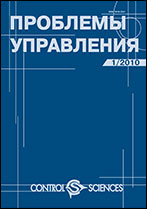|
Control in the socio-economic systems
Forming the generations of new technological products as a set covering problem
S. A. Barkalova, V. N. Burkovb, P. N. Kurochkaa, E. A. Serebryakovaa
a Voronezh State Technical University, Voronezh, Russia
b Trapeznikov Institute of Control Sciences, Russian Academy of Sciences, Moscow, Russia
Abstract:
The development of any enterprise implies improving its control mechanisms for the manager to make decisions based on the achievements of science rather than intuitive ideas of his (or her) personal experience. It is necessary to improve the model-building process in order to eliminate the coinciding peaks of resource consumption when working on multiple projects. For this purpose, the concept of a generation of new technological products can be adopted: a new product is formed from separate prototypes (operating models), which can serve to determine some features of the project under development. Naturally, it is unreasonable to include the entire model range in the generation of new technological products: one should select the minimum number of prototypes required. This problem belongs to the class of set covering problems: complete covering (when the selected prototypes must possess the entire set of properties possessed by the model series under development) or partial covering (when the selected prototypes must possess only some of these properties). Exact algorithms and approximate heuristic algorithms are presented to solve both problems.
Keywords:
placement problem, complete set covering problem, partial set covering problem, innovation lifecycle, generation of new technological products, prototype, properties matrix.
Received: 22.05.2023
Revised: 29.10.2023
Accepted: 30.10.2023
Citation:
S. A. Barkalov, V. N. Burkov, P. N. Kurochka, E. A. Serebryakova, “Forming the generations of new technological products as a set covering problem”, Probl. Upr., 2023, no. 6, 22–32; Control Sciences, 2023, no. 6, 18–26
Linking options:
https://www.mathnet.ru/eng/pu1331 https://www.mathnet.ru/eng/pu/v6/p22
|

| Statistics & downloads: |
| Abstract page: | 71 | | Full-text PDF : | 17 | | References: | 23 |
|




 Contact us:
Contact us: Terms of Use
Terms of Use
 Registration to the website
Registration to the website Logotypes
Logotypes








 Citation in format
Citation in format 